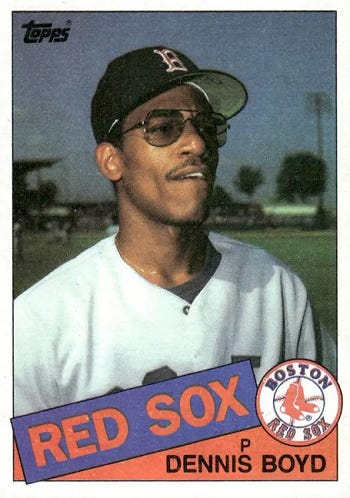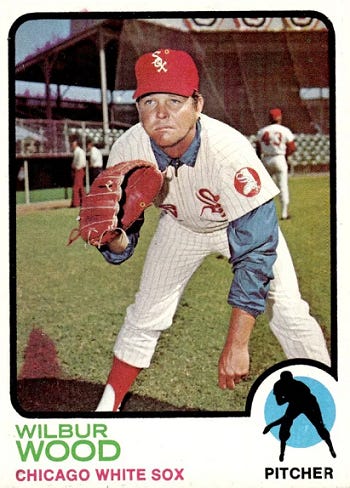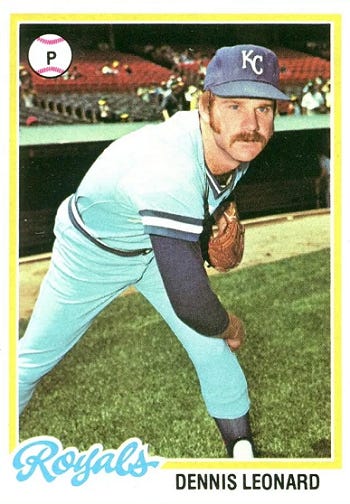Today, Oil Can Boyd turns 65 years old. In a way, he felt about that old to me when I first encountered him in my 1985 wax packs, like on his Topps rookie card (#116):
The impression of his being an old soul was reinforced when I started to see him pitch here and there on television — exaggerated delivery, small frame, big personality. And that’s where I also learned he was “Oil Can” and not Dennis, as our cards would have us believe.
Oil Can was also a pretty darn good pitcher, winning 12 games in 1984 and 15 in 1985. What I didn’t know until I found out about his birthday today, though, was that Boyd also “led” the majors by giving up 273 hits in ‘85, maybe his best all around season.
That seemed pretty amazing until I started digging a bit and found that there have been plenty of even more successful pitchers who gave up even bigger scads of hits in big-win seasons.
In fact, there have been plenty of 20-game winners who handed out hits like they were peanut butter kisses on Halloween night.
Here are five of them, along with their same-year baseball cards.
https://www.statmuse.com/mlb/ask/which-pitcher-had-the-most-hits-allowed-in-a-season-since-1980
1973 Topps Wilbur Wood (#150)
Wood rode his knuckleball to a couple of the most amazing pitching seasons any of us is ever likely to encounter: 24 wins, 49 starts, and 376.2 innings in 1972, followed by 24 wins, 48 starts, and 359.1 innings.
He led the majors in wins both of those years. Also in batters faced — 1490 and 1531. Probably shouldn’t be a surprise that he gave up a lot of hits those summers, huh?
Indeed he did, allowing 325 and 381 safeties, respectively, both majors-leading totals.
Wood’s run was even more impressive than that, though, as he won at least 20 games and gave up at least 270 hits every season from 1971 through 1974. He also gave up 309 hits while going 16-20 in 1975.
Amazingly, by all indications, his left arm remains attached to his body to this day.
1978 Topps Dennis Leonard (#665)
By many measures — especially wins — Leonard was the ace of the first great Royals teams, winning 20 games three times from 1977 through 1980 as Kansas City also won three division titles.
His even 20 Ws led the American League in 1977, when he finished fourth in Cy Young Award voting.
Leonard also gave up his share of hits allowed, topping 240 four times from 1976 through 1980. He was tops in the league in 1978, when he gave up 283 safeties.
Three years later, in the strike-shortened 1981 season, he led the majors with 202 hits allowed in 201.2 innings (also a majors-leading total).
1980 Topps Tommy John (#690)
John was always a threat to give up at least 200 hits, but after his eponymous elbow surgery, he topped the mark ten times in his final 14 seasons.
In 1979, he won 21 games for the Yankees while giving up a then-career-high 268 hits. He topped himself on both counts in 1980 with 22 wins and 270 hits allowed.
That was the end of John’s 20-win years, but he wasn’t done surrendering hits. In 1983, at the age of 40, he led the majors by giving up 287 hits.
1971 Topps Mickey Lolich (#133)
Lolich was the hero of the 1968 World Series for the Detroit Tigers, but he also put together a career record that’s not all that short of the Hall of Fame — and arguably as good or better than some already enshrined.
Cooperstown aside, Lolich also put together a 1971 season that Wood might have used as a template for what was possible in the coming campaigns. To wit, Lolich’s 25 wins, 45 starts, 376 innings pitched, 308 strikeouts, and 1538 batters faced all led the majors.
His 29 complete games also led the American League, one behind Fergie Jenkins’ majors-leading 30 for the Cubs.
And, as you might have guessed, there was another world-leading total in Lolich’s ledger come season’s end: 336 hits allowed.
Lolich won 22 games in 1972, but gave up “only” 272 safeties. He was back over 300 in both 1973 and 1974 but fell short of 20 wins those years (16 in both seasons).
1973 Topps Jim Colborn (#408)
Colborn spent the first three years of his big league career with the Cubs, appearing mostly in relief. After a December 1971 trade to the Brewers, Colborn went 7-7 across 39 appearances with Milwaukee in 1972. Twelve of those were starts.
Then, in 1973, Colborn spent most of the summer in the rotation, notching 36 starts among his 43 mound appearances. He rewarded the Brewers with a 20-12 record and 3.18 ERA in 314.1 innings.
That summer, the right-hander garnered his only All-Star nod and picked up his only Cy Young votes, finishing sixth in the American League.
And, oh yeah — he also gave up 297 hits along the way.
Colborn spent the next three seasons with the Brewers before joining Leonard in the Royals’ rotation following a December 1976 blockbuster that also brought Darrell Porter to Kansas City.
—
There were plenty of other big-time winners in the 1970s and early 1980s who also gave up big-time numbers of hits, including Jim Kaat, Phil Niekro, Bert Blyleven, Gaylord Perry, and Joe Niekro.
All of which sort of proves the old adage that goes (to paraphrase): “A guy has to be pretty good to give up 300 (or so) hits.”
A guy also has to be pretty good — at least for a couple-few hours — to pitch a no-hitter. If you want the definitive resource(s) about these pitching gems, you’re in luck!
Hot off the presses in the last week or so is From Randy Johnson to Dallas Braden: No-hitters Beyond the Box Score, a two-volume opus about — you guessed it — major league no-hitters, absolutely jam-packed with interviews, stories, stats, and amazing facts. There’s so much info in this one, that author Kevin Hurd and his editor, Bruce Hurd (yes, they’re brothers), had to split the book in two. All told, it’s nearly 600 pages of no-hitter splendor.
The books are available on Amazon in paperback, hardcover, and ebook versions:
Volume I: https://www.amazon.com/dp/B0DHYHBQ5W
Volume II: https://www.amazon.com/dp/B0DHYP3J46
Happy reading, and thanks for reading.
—Adam











Wonderful trip down memory lane, as usual. Thanks for sharing. Colborn threw the Royals first no-hitter in ‘77. It was a huge deal in our mid-western parts, especially that it came against a main regional rival, the Rangers. My older brother’s church youth group went to that game at Royals stadium. ✌️⚾️✌️
Just gonna leave this right here, Adam...
(assuming you're not already a member)
https://ibwaa.com/